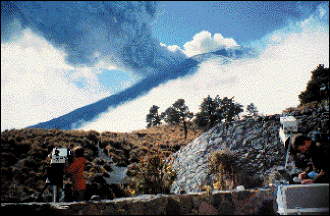Barbara Grant
MEXICO CITY -- A Pan-American research team has been using photonics to watch a nearby volcano in hopes of learning how to forecast eruptions, assess health risks for people who live near volcanoes and determine volcanoes' effects on air pollution.
Los Alamos National Laboratory researchers Fraser Goff, Steve Love and Dale Counce recently joined vulcanologist Claus Siebe of La Universidad Nacional Autonóma de Méjico to measure sulfur dioxide, water vapor, hydrochloric acid and other gases emitted by Popocateptel, an active, 17,800-ft volcano 50 miles southeast of Mexico City.

Dale Counce and Steve Love study the gases that pour from the Popocateptel volcano in Mexico in hopes of better understanding volcano chemistry. Courtesy of Los Alamos National Laboratory.
|
Love, a physicist in the New Mexico lab's Astrophysics and Radiation Measurements Group, explained that correlating gas composition with a volcano's eruptive behavior will aid scientific efforts to forecast eruptions. The data obtained in the experiment also can be used to assess health risks for people who live near a volcano, and to understand how a volcano contributes to atmospheric trace gases and aerosols.
Sampling from a distance
The researchers hope to refine their measurement techniques and develop instrumentation that can be used for long-term monitoring by ground-based, airborne or spaceborne remote sensors.
One challenge the researchers faced was obtaining high-quality data at a safe distance from the volcano. Love used a Fourier transform infrared spectrometer up to 10 km from the crater to measure gases using ambient IR radiation. Other approaches to measurement use either an artificial IR source or hot volcanic rocks near a crater rim.
The thermal contrast between the volcanic plume and its background provided researchers with enough signal to make spectral measurements in the thermal infrared.
In the midwave region (3 to 5 µm), Love employed another strategy. By using sunlight scattered off nearby clouds, he was able to obtain a background source significant enough to contrast with the plume's spectral absorption in the same region. And because scattered sunlight is even brighter at shorter wavelengths, a 2.5-µm hydrofluoric acid peak was easy to detect. "No other vulcanology group has been able to measure [hydrofluoric acid] in the field," Love said.
Working at shorter wavelengths, Counce, a chemist in the Geology and Geochemistry Group, used a COSPEC V correlation spectrometer developed by Barringer Research Ltd. of Toronto, Ontario, Canada, to obtain sulfur dioxide readings between 290 and 320 nm. COSPEC provided the absolute concentration of sulfur dioxide in the plume and allowed the team to determine concentrations of other gases based on information from the Fourier transform infrared spectrometer.
Internal sources within each instrument provided on-site calibration, but before leaving for Popocateptel, the American researchers took advantage of a source closer to home. The Four Corners Power Plants near Farmington, N.M., emit known concentrations of gases similar to those generated by volcanoes. Calibrating their instruments using emissions from the plants helped the team fine-tune its data collection methods before applying them in the field, Counce said.
